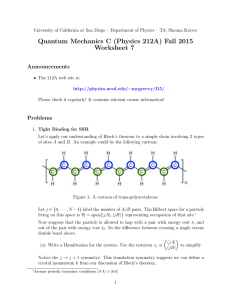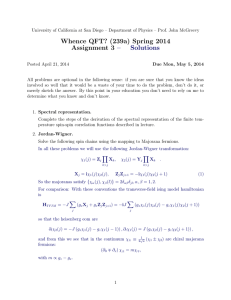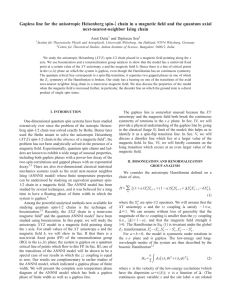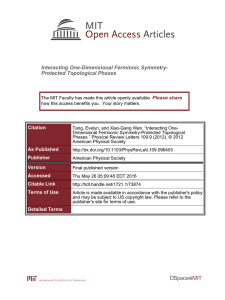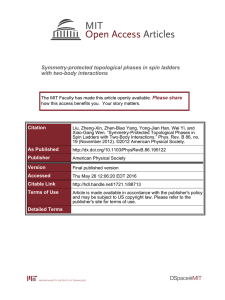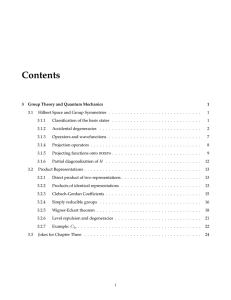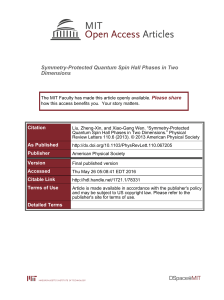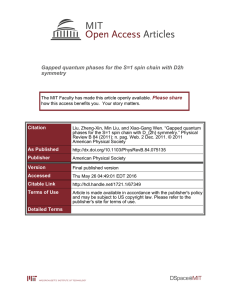Quantum Mechanics C (Physics 212A) Fall 2015 Worksheet 7 – Solutions
advertisement
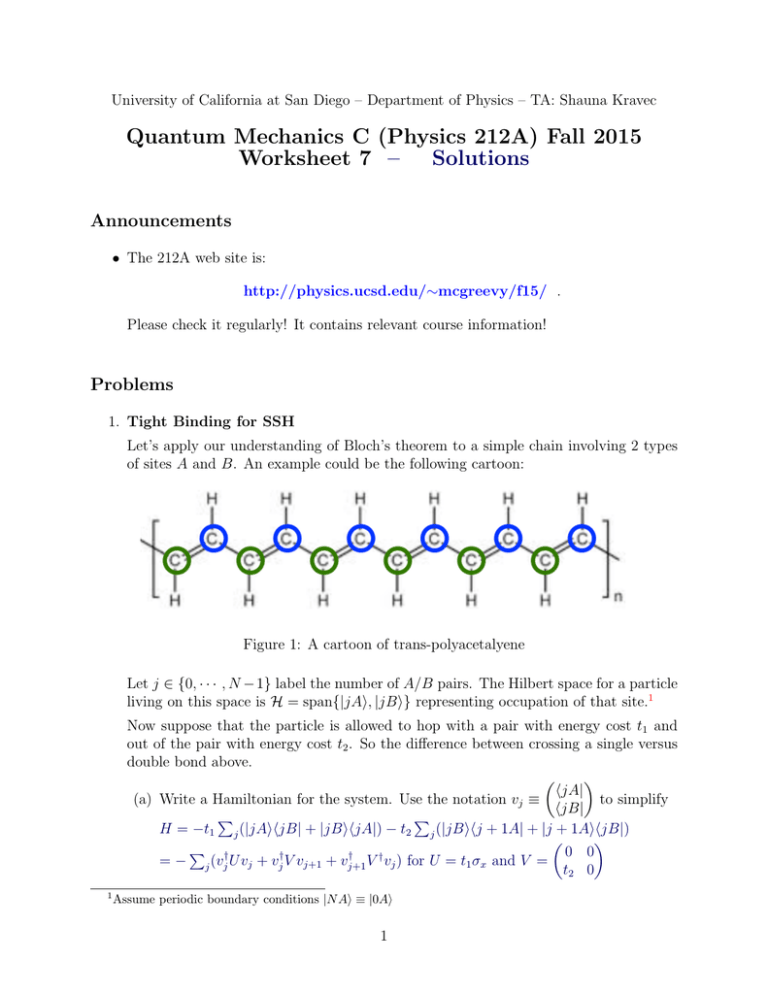
University of California at San Diego – Department of Physics – TA: Shauna Kravec
Quantum Mechanics C (Physics 212A) Fall 2015
Worksheet 7 –
Solutions
Announcements
• The 212A web site is:
http://physics.ucsd.edu/∼mcgreevy/f15/ .
Please check it regularly! It contains relevant course information!
Problems
1. Tight Binding for SSH
Let’s apply our understanding of Bloch’s theorem to a simple chain involving 2 types
of sites A and B. An example could be the following cartoon:
Figure 1: A cartoon of trans-polyacetalyene
Let j ∈ {0, · · · , N − 1} label the number of A/B pairs. The Hilbert space for a particle
living on this space is H = span{|jAi, |jBi} representing occupation of that site.1
Now suppose that the particle is allowed to hop with a pair with energy cost t1 and
out of the pair with energy cost t2 . So the difference between crossing a single versus
double bond above.
hjA|
(a) Write a Hamiltonian for the system. Use the notation vj ≡
to simplify
hjB|
P
P
H = −t1 j (|jAihjB| + |jBihjA|) − t2 j (|jBihj + 1A| + |j + 1AihjB|)
P †
0 0
†
†
†
= − j (vj U vj + vj V vj+1 + vj+1 V vj ) for U = t1 σx and V =
t2 0
1
Assume periodic boundary conditions |N Ai ≡ |0Ai
1
Notice the j → j + 1 symmetry. This translation symmetry suggests we can define a
crystal momentum k from our discussion of Bloch’s theorem.
P
(b) Define the Fourier transform vj = √1N k eikj vk and use this to write the HamilP
tonian as H = − k vk† H(k)vk . What is H(k)?
We can just directly
theP
transformation
in our Hamiltonian. Let’s look
P †substitute
P
P i(k
0 −k)j
†
1
0
term by term: j vj U vj = N k k0 vk U vk
je
P i(k0 −k)j
P †
1
0
0 so we can do the sum over j and k to get
e
=
δ
k,k
j
k vk U vk
N
P †
P P †
P ik0 (j+1) −ikj P † ik
1
Similarly j vj T vj+1 = N k k0 vk T vk0 j e
e
= k vk T e vk
0
t1 + t2 e−ik
So H(k) =
t1 + t2 eik
0
(c) Diagonalize H(k) to find the energies Ek . You should get two eigenvalues or
bands. What happens when t1 = t2 ?
p
H(k) = (t1 + t2 cos(k))σx + t2 sin(k)σy so Ek = ± (t1 + t2 cos(k))2 + (t2 sin(k))2
p
Or more simply Ek = ± t21 + t22 + 2t1 t2 cos(k)
I’ve included a Mathematica notebook to visualize. There’s an energy gap at
every point in (t1 , t2 ) space except t1 = t2 where E = 0 at k = π
So what we have is a model of an insulator with two distinct phases. One where t1 > t2
and another where t2 > t1 . The bands cross at the phase transition. Is there another
way to connect the regions to avoid the phase transition?
P
P
(d) Consider the following projectors PA ≡
i |iAihiA| and PB ≡
i |iBihiB| to
make the operator: Σ ≡ PA − PB . Show that Σ is unitary and hermitian
P
The operator is effectively a sum of j Zj where Zj acts on the j-th pair.
(e) Show that ΣH(k)Σ = −H(k) it is a chiral symmetry. What does this imply for
the spectrum of H(k) ?
It’s sufficient to check that ZH(k)Z = −H(k) implying that if H|Ei = E|Ei that
HΣ|Ei = −ΣH|Ei = −EΣ|Ei
For every eigenstate of momentum k and energy E there’s another with energy
−E. This is visible in the spectrum.
(f) Apply your knowledge of avoided crossing to answer: what sort of term should
you add to H(k) to connect the eigenvalues?
How does this term transform under Σ?
You would P
need to add a term proportional to σz in H(k) so something onsite
like V = ∆ j (|jAihjA| − |jBihjB|) but this transforms with opposite sign from
the rest of the Hamiltonian.
In this way the model is protected by the symmetry Σ. You can only connect the two
phases by breaking the symmetry or going through a phase transition.
So what makes these phases different?
2
(g) Define q(k) ≡
h(k)
|Ek |
for H(k) =
0
h(k)
. Convince yourself this is a map
h† (k)
0
from the circle to the circle.
−ik
for which you can check has |q(k)| = 1
q(k) = √ 2 t12+t2 e
t1 +t2 +2t1 t2 cos(k)
Since k ∈ {−π, π} it is a map from S 1 → S 1 . See the Mathematica file
R
(h) Define the winding number of q(k) to be ν ≡ 2πi dk 1q ∂k q. What is it for the
different values of (t1 , t2 ) ?
I’ve numerically evaluated it in the notebook
This is a topological difference between the phases; the winding number can’t change
continuously.
3
